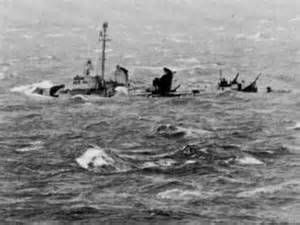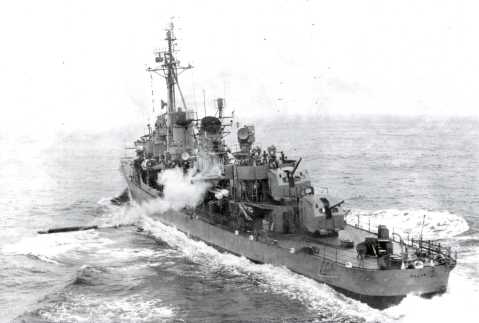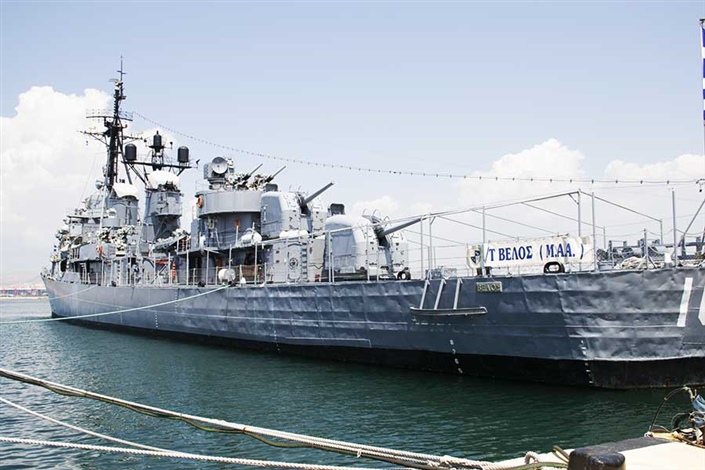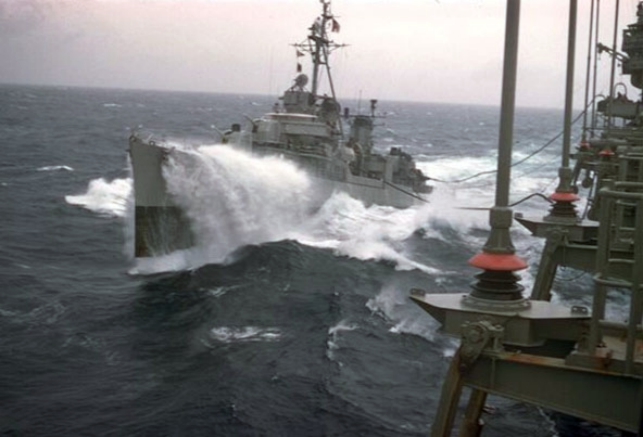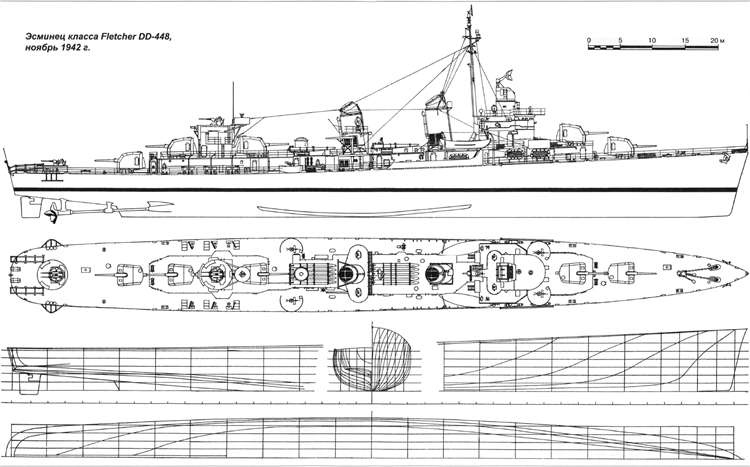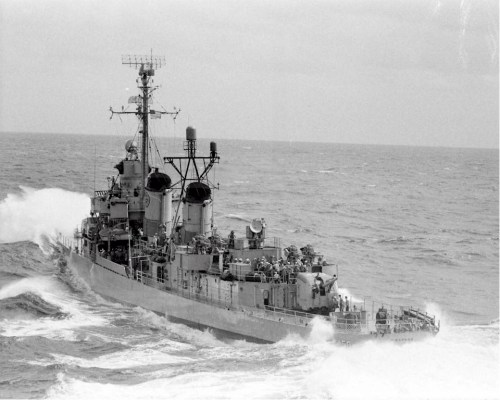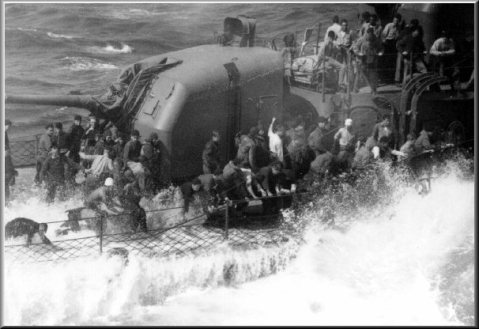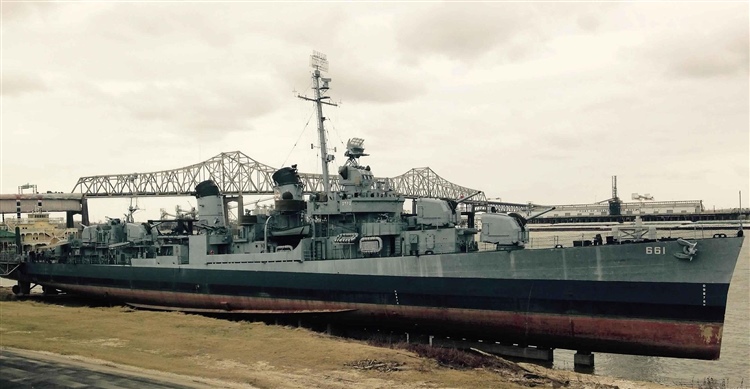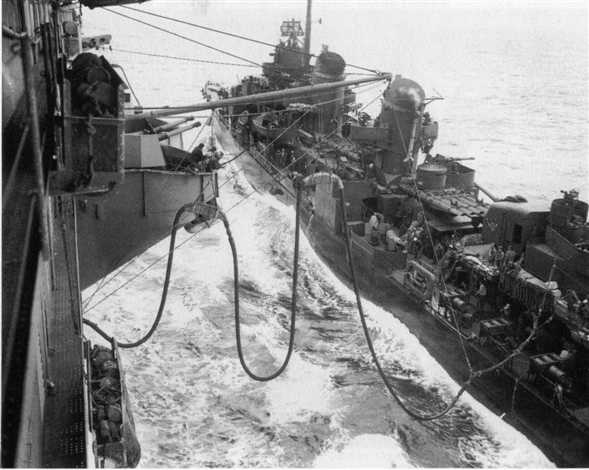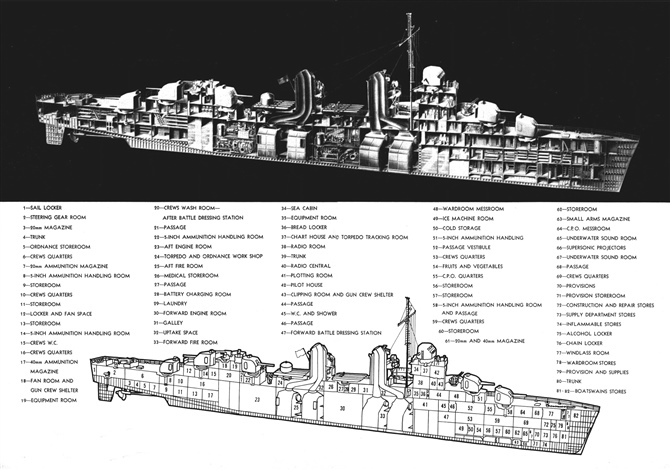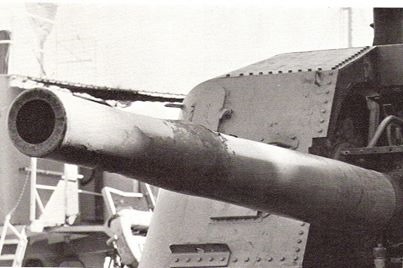Fletcher Class
175 Fletcher Class Destroyers were commissioned
by Captain George Stewart, USN (Retired) as reported on www.NavyHistory.com
The Fletcher class destroyers were authorized as part of the 1941-42 Shipbuilding Program. They incorporated many lessons learned from earlier classes of destroyers built during the 1930s and in the early stages of World War II, particularly relating to stability and sea keeping ability. During the 1930s, the Navy had produced a succession of “step deck” destroyer designs with raised forecastles. But the Fletcher Class reverted to a “flush deck” design like the destroyers of World War I. Most of the ships were initially assigned to the Pacific Fleet where they were to play a major role in the war.
A total of 175 Fletcher Class Destroyers were commissioned between 4 June 1942 and 22 February 1945. The lead ship of the class was USS Fletcher (DD 445). Hull numbers ranged between 445 and 691 plus an additional block between 792 and 804. The ships were built in 11 different shipyards. A total of 19 ships of the class were lost to war action and 6 more were damaged beyond repair. My ship, USS Halsey Powell (DD 686) was built at Bethlehem Steel, Staten Island. It was commissioned in October 1943.
The major ship characteristics were as follows:
Length – 376.5’
Beam – 39’7”
Draft – 18’
Standard Displacement – 2150 Tons
Screws – 2
Rudders – 1
Power – 60,000 HP
Design Speed – 36 Knots
Range – 4790 nautical miles at 15.8 knots
Wartime Complement – 329 Personnel
Normal peacetime – 14 Officers – 236 Enlisted
The Main Battery consisted of five single dual purpose (Surface to surface and Anti-Air) 5”/38 Gun Mounts. Two mounts were located forward and three aft. Mounts were numbered consecutively from forward to aft (51, 52, 53, 54, and 55). These mounts had a firing rate up to 18 rounds per minute. Effective range was 17,306 yards at 45° elevation and altitude of 32,250 feet at 85° elevation. The total crew for reach mount was approximately 20, counting personnel in the mount, upper and lower handling rooms, and projectile & powder magazines. The guns used semi-fixed ammunition (projectile and powder loaded separately). Guns could be fired using radar, computer generated, or visual information. All training, elevation, and firing was normally controlled from the Mk 37 Director on top of the pilot house. However all loading functions were accomplished manually. There was a 5 inch loading machine on the main deck amidships that replicated the loading mechanism of the guns. These were used for training gun crews.
Occasionally I was assigned duties as check sight observer during live firing exercises. My purpose was to look through a telescope and ensure that the gun was pointed where it should be. This was an assignment that I absolutely loathed.
The destroyer was originally conceived as a counter to high speed torpedo boats around the turn of the century. The first US Navy destroyer was USS Bainbridge (DD 1), which entered service in 1903. By the time of World War I, the destroyer had become a major part of the fleet. During that war its primary duties were convoy escort and antisubmarine patrol. Originally, the primary purpose of the ships was to deliver torpedoes against surface targets and this thinking carried over into World War II. Therefore, the Fletchers were originally fitted with two five tube surface to surface torpedo mounts, each located immediately aft of one of the stacks. As the threat imposed by aircraft became more apparent, one of the mounts was later removed and replaced with anti-aircraft protection.
Another reason for the demise of the surface to surface torpedo was the invention of radar which essentially destroyed any stealth advantages that the destroyer possessed. I only remember a couple of live firing exercises. The approach was by the “John Wayne” method consisting of a 25 knot approach, delivery of the weapon, and a high speed retreat.
The surface to surface torpedo essentially disappeared from the post war fleet, although destroyer types were later fitted with anti-submarine homing torpedoes.
Other weaponry included:
Two quad (4 barrel) 40 MM AA gun mounts – These replaced the forward torpedo mount.
Three twin (2 barrel) 40 MM gun mounts
Two depth charge tracks
Six depth charge projectors
Six 20 MM gun mounts
After the war all 20 MM gun mounts were removed and the forward 40 MM mounts were replaced by a pair of ahead thrown anti-submarine projectile (Hedgehog) mounts. Additionally, a number of the ships had their 40 MM mounts replaced by 3”/50s.
Fletchers were the first destroyers to be fitted with radar. The ships carried surface search, air search, and fire control radars. The surface search radar had a range out to the horizon (about 10-12 miles) while the air search (when it worked) could see out to about 40-45 miles. The fire control radar was used strictly for control of the 5” gun battery.
The advent of radar resulted in a new space being created, called the Combat Information Center (CIC). On Halsey Powell, it had been converted from what was originally the unit commander’s cabin. The CIC later evolved into the major nerve center for conducting all surface, subsurface, and anti-air/missile operations aboard naval ships.
The ships were propelled by a twin screw steam propulsion plant rated at 60,000 HP that could produce a maximum speed somewhere between 35 and 37 knots. Considering that this was with 1930s technology, this was a very respectable level of power and it would still be considered as such today.
There were two cross compounded geared steam turbine main engines. Each engine consisted of a high pressure (HP) and low pressure (LP) turbine set driving its associated propeller shaft through a double reduction gear. The rated output of each engine was 30,000 HP at a propeller speed of 395 RPM. The HP and LP turbines were connected in series with respect to steam flow and in parallel mechanically into the reduction gear. A smaller cruising turbine was mounted on the front end of the HP turbine. Astern elements were provided in the LP turbine. To go astern you had to shut off steam to the ahead turbines before you could admit steam to the astern turbine. Control was manual; by hand wheels mounted on a large gage board adjacent to the engine in response to engine order telegraph signals from the bridge.
The electrical plant consisted of two 350 kW 450 VAC steam turbine driven ship service generators (SSTG), one in each engine room plus a 100 kW emergency diesel generator located in the forward part of the ship. By comparison, a modern destroyer has three 2500 to 3000 kW generators.
Machinery spaces were in an echelon arrangement, with alternating fire rooms and engine rooms. The starboard shaft was about 75’ longer than the port shaft. This provided for redundancy in the event of battle damage and it remains the practice today on twin screw naval vessels. From forward to aft, the spaces were:
Forward (#1) Fire Room containing #1 and #2 Boilers and associated forced draft blowers, fuel pumps, and associated equipment.
Forward (#1) Engine Room containing the Starboard (#1) Main Engine, #1 ship service generator, a 12,000 gallon per day distilling plant, and associated auxiliary equipment. This was designated as the Control Engine Room and it was the station for the Engineering Officer of the Watch (usually a CPO) who was responsible for coordinating the operation, including communications with the bridge. This was the Chief Engineer’s station when entering or leaving port or under battle conditions.
After (#2) Fire Room containing #3 and #4 Boilers and associated equipment. Except for the starboard shaft running through it, the space was essentially the same as the Forward Fire Room.
After (#2) Engine Room, essentially a mirror image of the Forward Engine Room containing the Port (#2) Main Engine, #2 generator, and associated equipment.
Normal steaming configuration was with two boilers on the line in a “Split Plant” configuration with one boiler in each fire room supplying its associated engine and all valves connecting the forward and after plants closed. Essentially this provided two completely independent engineering plants. Two boilers were capable of providing speeds up to 28 knots which was adequate for most operations.
Access to each of these spaces was by hatches and vertical ladders to the Main Deck above. There were two means of egress from each space, one port and one starboard. There was no access between spaces below the Main Deck. To go between machinery spaces it was “up and over”.
An environmentalist would look askance at ships of this era. All commodes and urinals discharged directly overboard. When I was Chief Engineer, my night orders told my sailors to only pump bilges at night while in port. We still had the capability to lay smoke screens. All trash and garbage was dumped overboard at sea. The ships had to take on sea water ballast directly into the fuel tanks to maintain stability under light loading conditions and deballasting operations at sea took several hours during which we would be discharging a nasty looking oil slick. The machinery spaces were loaded with asbestos insulation. Fortunately, we do much better today at protecting the environment.
Living accommodations were nothing to brag about. Sailors were berthed by division in 4 high tiers of canvas bunks with upright lockers. The practice of placing portholes in the side for ventilation had gone away and there was no air conditioning. The galley was on the main deck and all food had to be carried down in large trays to the mess deck below. A drawback to the ship design was the lack of a fore and aft passage inside the ship, making it possible for the two ends of the ship to be cut off from each other during bad weather when it was unsafe to go out on deck.
The Chief Petty Officers had their own mess. But their berthing accommodations were not much better than those of the crew. As officers we lived somewhat better, but our accommodations were not very sumptuous either. The captain had his own cabin and head. He also had a small sea cabin adjacent to the bridge. The wardroom and officers mess was on the Main Deck forward, just aft of Mount 52. All of the rest of us lived one deck down in “Officer’s Country” in small two man staterooms. We all shared the same head. Only the Executive Officer had his own stateroom.
The Fletcher class destroyers are still regarded as the best destroyers produced by any navy during World War II. The Sumner (DD 692) and Gearing (DD 710) class ships were essentially improved versions of the Fletchers. But they did not really get into the war soon enough to make as much of an impact. Because the navy had a surplus of ships after the war, many of the Fletcher Class destroyers, including Halsey Powell were decommissioned, and placed into reserve fleets in 1946.
Halsey Powell and many of her sister ships were re-commissioned in 1952 at the outbreak of the Korean War. By the 1960s a number of them, including Halsey Powell had been assigned to Naval Reserve training duties. In the early 1960s the navy embarked on a major effort referred to as the FRAM (Fleet Rehabilitation and Modernization) program. But the majority of the ships upgraded under this program were of the Sumner and Gearing classes.
Some Fletchers were still around during the Vietnam War, but all had been decommissioned by 1971. Thirty Two were sold to foreign navies, including my old ship, USS Halsey Powell which became the ROK Seoul. The last active Fletcher was the USS John Rogers (DD 574) which served in the Mexican Navy until 2001. For those interested in visiting a Fletcher class museum ship, there are three located around the United States: USS Cassin Young (DD 793) in Boston, MA, USS Kidd (DD 661) in Baton Rouge, LA, and USS The Sullivans (DD 537) in Buffalo, NY.



